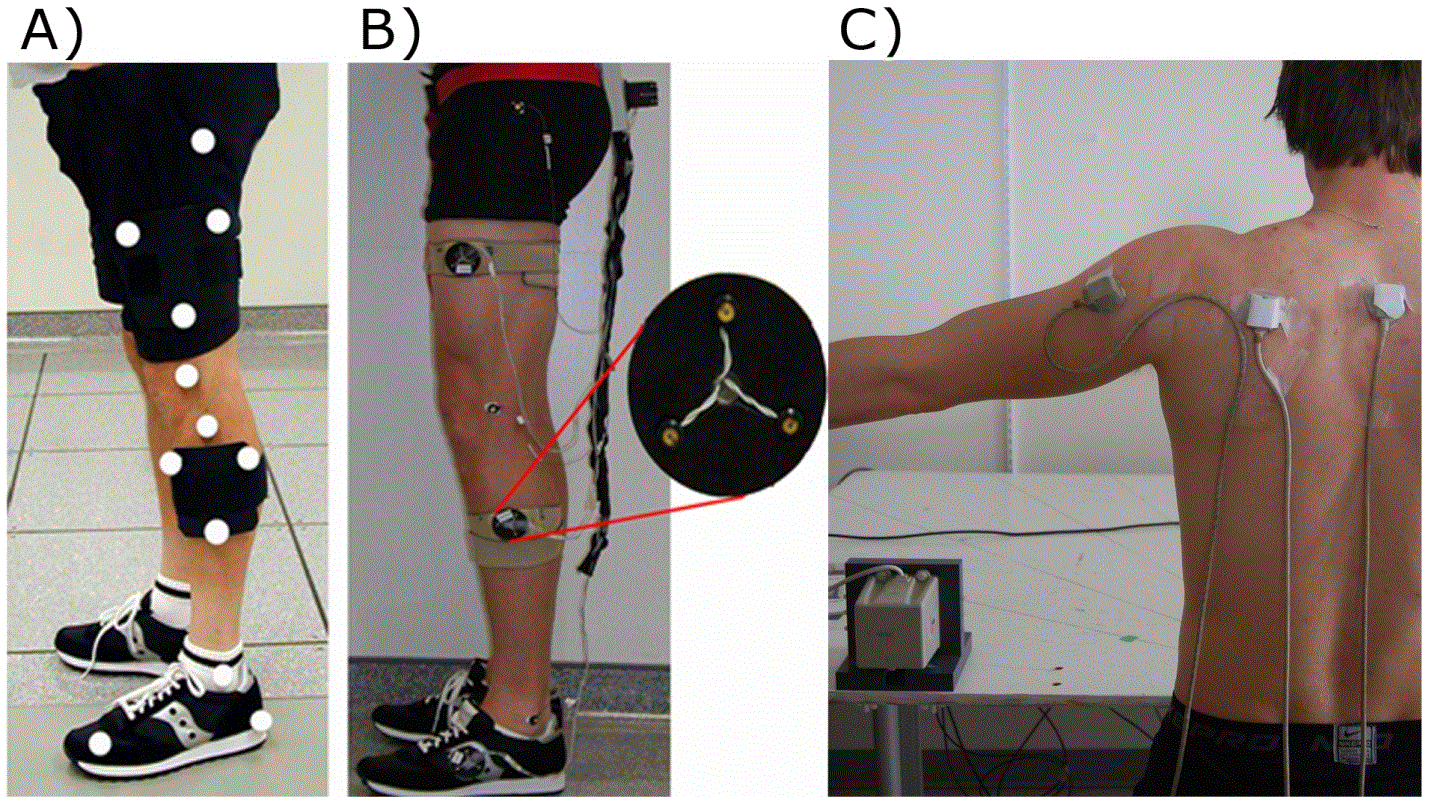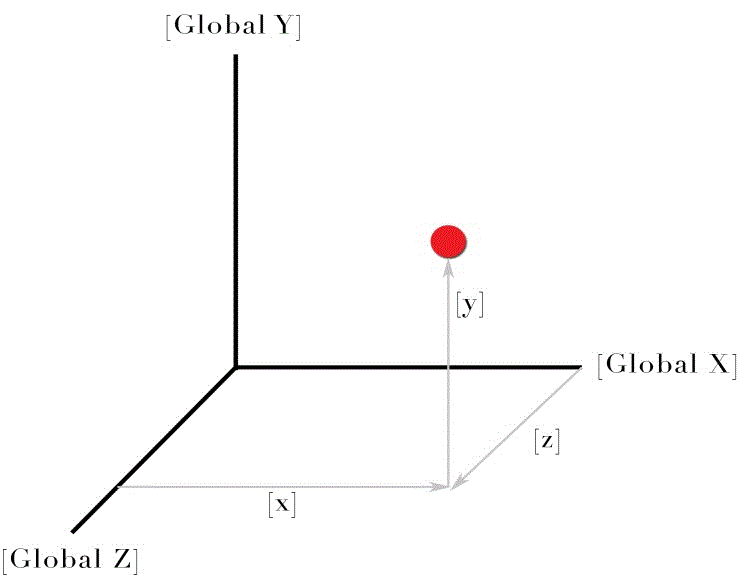Three-dimensional biomechanical research is well established and advanced analysis systems have continued to evolve. These systems may have passive (VICON (b) and Qualysis (c)), active (Northern Digital Inc. (a)) or electromagnetic (Polhemus (d) and Ascension (e)) motion capture properties that are independently unique yet synonymously implemented in research to capture movement in 3-D. Recently, systems to track 3-D motions have targeted a clinical audience (f), (g), where previously this technology was primarily used for a research focus. If this is the future, clinicians should have a basic understanding of 3-D methodologies. To start, a brief mathematical description is warranted to provide the necessary background.
Three-dimensional motion capture utilizes, what is often referred to as an X, Y, Z Cartesian coordinate system and is considered a standard in reporting kinematic data as recommended by the International Society of Biomechanics (ISB) [
2,
9]. During camera-based analysis, this coordinate system can be derived from any set of three skin surface markers that are not all in a straight line (non-collinear) [
2,
15] (Figure 1). In the case of electro-magnetic motion capture [
4,
5], specially designed magnetic sensors are employed that are sensitive to movement in each of the three Cartesian axes. In practical terms, each marker/sensor can be described, relative to a global coordinate system (i.e. the room), by the corresponding units X, Y, and Z (Figure 2).
Using these principles, an organized system of coordinates is mathematically established that gives reference to the rigid segments monitored throughout movement [
2,
15]. These rigid segments relate to segment anatomy based on anatomical landmark identification. Rigid segments in the lower extremity typically analyzed during gait include the pelvis, thigh, shank and foot segments [
16-
19]. The thorax, scapula and humerus are often described as rigid bodies during shoulder movement analysis [
20-
22]. Three-dimensional (X, Y, Z) movement can be captured through the analysis of one rigid segment coordinate system with respect to another (i.e. tibia with respect to femur). As each Cartesian coordinate axis orientation within each rigid segment is orthogonal (i.e. perpendicular), three independent movements can now be derived [
15]. These movements correspond to clinical osteokinematic nomenclature; flexion/extension, abduction/adduction and internal/external rotation. The scapular convention has included; medial/lateral rotation, anterior/posterior tilt and upward/downward rotation [
5].
Research investigating the dynamics of human movement, with the exception of the electro-magnetic properties of the Polhemus 3-space Fastrak (d) and Ascension Flock of Birds (e) systems, utilize cameras with shutter speeds typically between 50-120 Hz for most clinical applications. These cameras are standardized to laboratory position and orientation [
15,
23]. The number of camera positions can be task specific. If the movement involves a walking task, cameras in two positions might be sufficient in ensuring that all the markers are captured [
24]. In contrast, if the movement involves cutting and twisting, more positions will be required to guarantee that all of the markers are identified [
12,
25]. This concept of redundancy ensures the markers are captured continuously, regardless of subject orientation.
Although marker-less motion capture systems such as the Microsoft kinect™ are being developed in an effort to evaluate human movement in a natural setting [26], marker based systems are currently state-of-the-art. Skin surface markers can be passive or they can be active. The passive markers are retro-reflective and the specially designed cameras that emit infrared stroboscopic illumination are used to capture the position of the marker (VICON (b) and Qualysis (c)). These systems do not require the use of wires and connection hardware. Conversely, active markers contain light emitting diodes, pulsed in sequence allowing the motion capture system to detect their location (Northern Digital Inc. (a)). Figure 1 illustrates both marker systems. The size of the markers, as well as the calibration volume can affect the accuracy of the measurement [
6,
7,
27,
28].
Previous comparison studies have found mean absolute errors in spatial recognition to be less than five mm for the VICON (b), Qualysis (c) and Northern Digital Inc. (a) systems [
6,
7]. Generally, active markers produce a more accurate result, although require lead wires and power equipment that may encumber natural movement. For instance, the optoelectronic Northern Digital Inc. Optotrak (a) camera system utilizes an active LED marker system and was found to have a 1.0 mm mean average error during standardized measurement tasks [
6]. In clinical nomenclature, knee flexion angle error has been found to be less than two degrees using optoelectronic camera equipment such as the Optotrak (a) system [
29]. For camera-based systems, the volume of measurement area and skin marker size is inversely related to the accuracy of the measurement. Each of these elements of motion capture must be taken into account when extrapolating the results.
Camera based systems track skin surface markers during movement where the Polhemus 3-space Fastrak (d) system and the Ascension Flock of Birds (e) are motion capture devices that utilize changes in electro-magnetic fields to capture movement [
4,
5]. These systems appear to be more prevalent in studies involving the kinematics of the spine [
30-
32], scapula and shoulder [
5,
20,
21,
33]. Electro-magnetic motion capture relies on receiver sensors mounted to the skin and must be in close orthogonal approximation to the central transmitter. The absolute errors of such systems have been shown to be within 1-2 mm, however the accuracy of these measures were linearly dependent on the sensors distance from the central transmitter [
34]. In addition, these systems are sensitive to magnetic distortion created from metal within the capture volume [
34]. Karduna et al. [
5] validated the use of electromagnetic motion capture for scapular kinematics and found low root mean square errors when capturing movement below 120 degrees of humeral-thoracic elevation. For instance, in the case of upward scapular rotation, errors were less than 10% of the total range of motion [
5]. In the case of spinal and scapular kinematic investigation, the motion capture volume has been controlled within a range from the central receiver [
35,
36]. This requirement would not provide sufficient volume for capturing dynamic gross motor function, such as over ground walking. In these instances, camera-based systems have been employed.
Many motion 3-D motion capture systems are technologically advanced in comparison to traditional two-dimensional motion capture systems. The application of the 3-D systems in rehabilitation and medical research is vast and continuing to expand as access to this technology increases. For instance, the EMOVI (g) KneeKG™ and 3D Gait (f) platforms have emerged in recent years. The implementation of relevant literature in clinical practice will further expand the value of these research methods.


